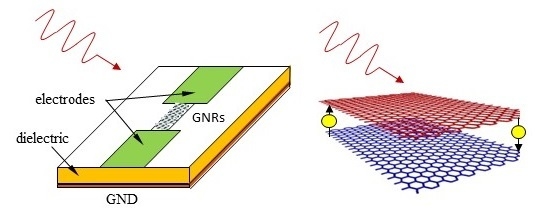A New Mechanism for THz Detection Based on the Tunneling Effect in Bi-Layer Graphene Nanoribbons
Abstract
:1. Introduction
2. Electrical Response of a Bi-Layer Graphene Nanoribbon THz Detector

2.1. A Glimpse at the Graphene Nanoribbon Band Structure
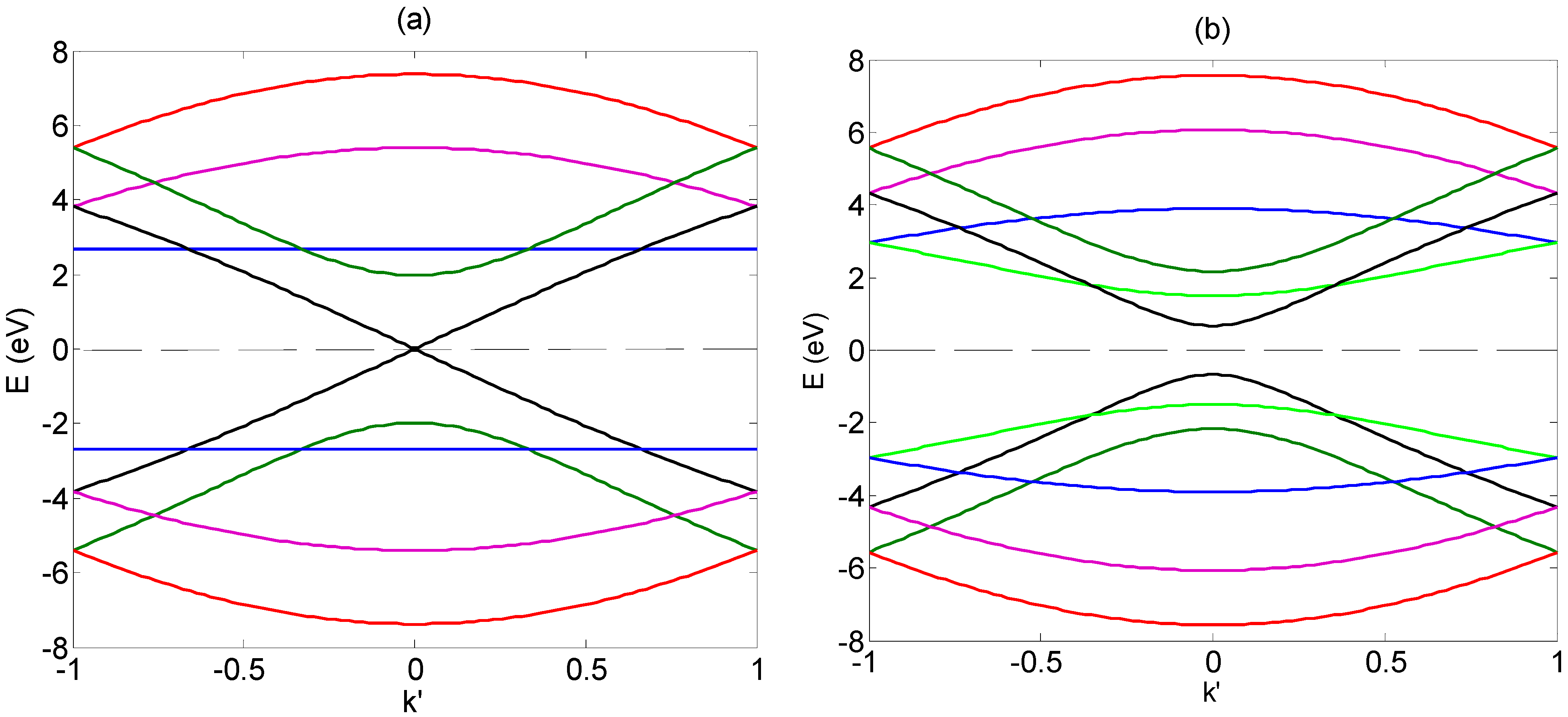
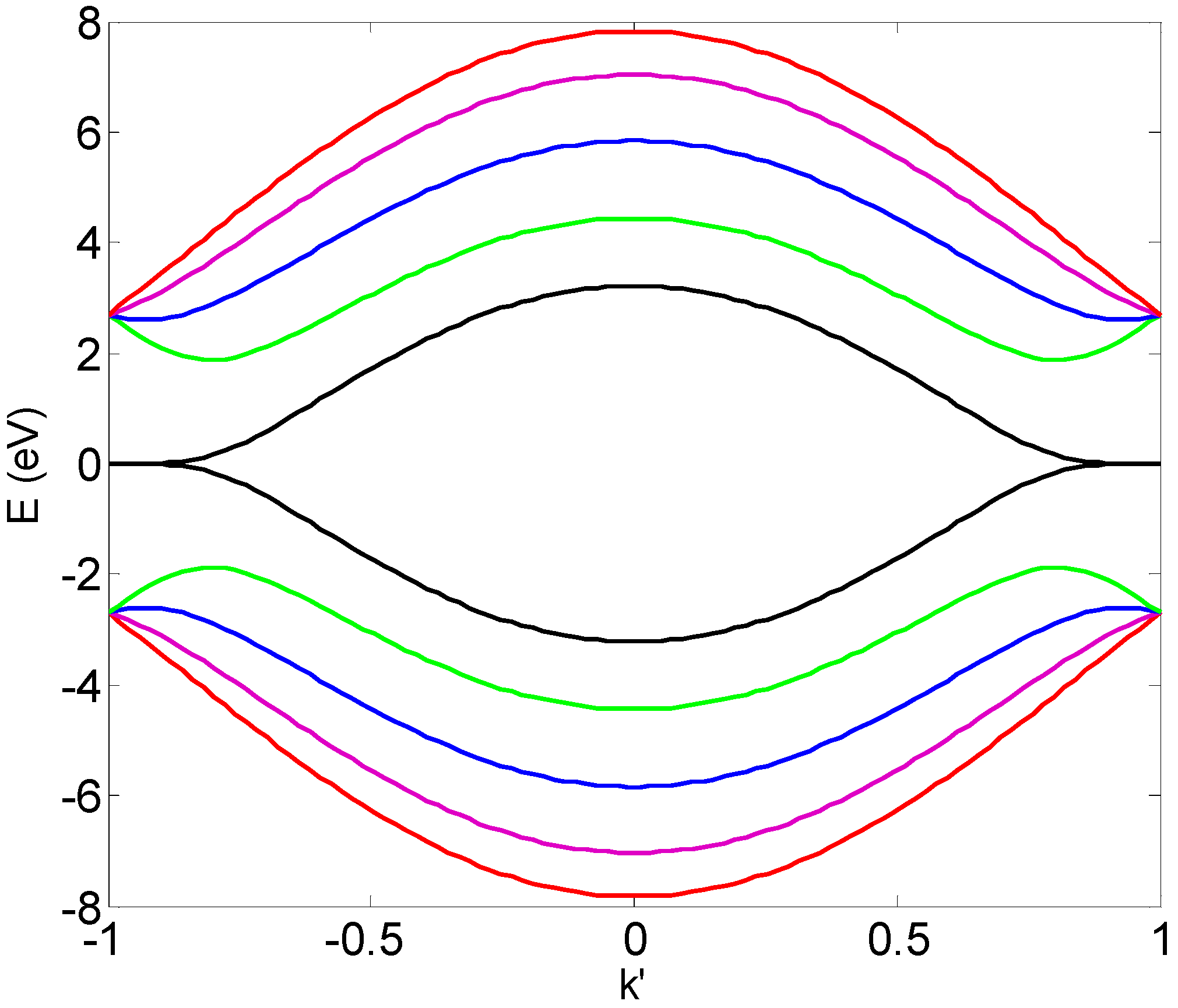
2.2. Transport Model along Graphene Nanoribbons, without the Tunneling Effect
- (i)
- the GNR width w is electrically small;
- (ii)
- the transverse currents may be neglected; and
- (iii)
- only intraband transitions are considered, whereas interband ones are not allowed.
2.3. Transport Model along Graphene Nanoribbons, with the Tunneling Effect
3. Discussion: Two Mechanisms of THz Resonance Excitation for the Proposed Detector
3.1. Interpretation of the THz Plasmon Resonances
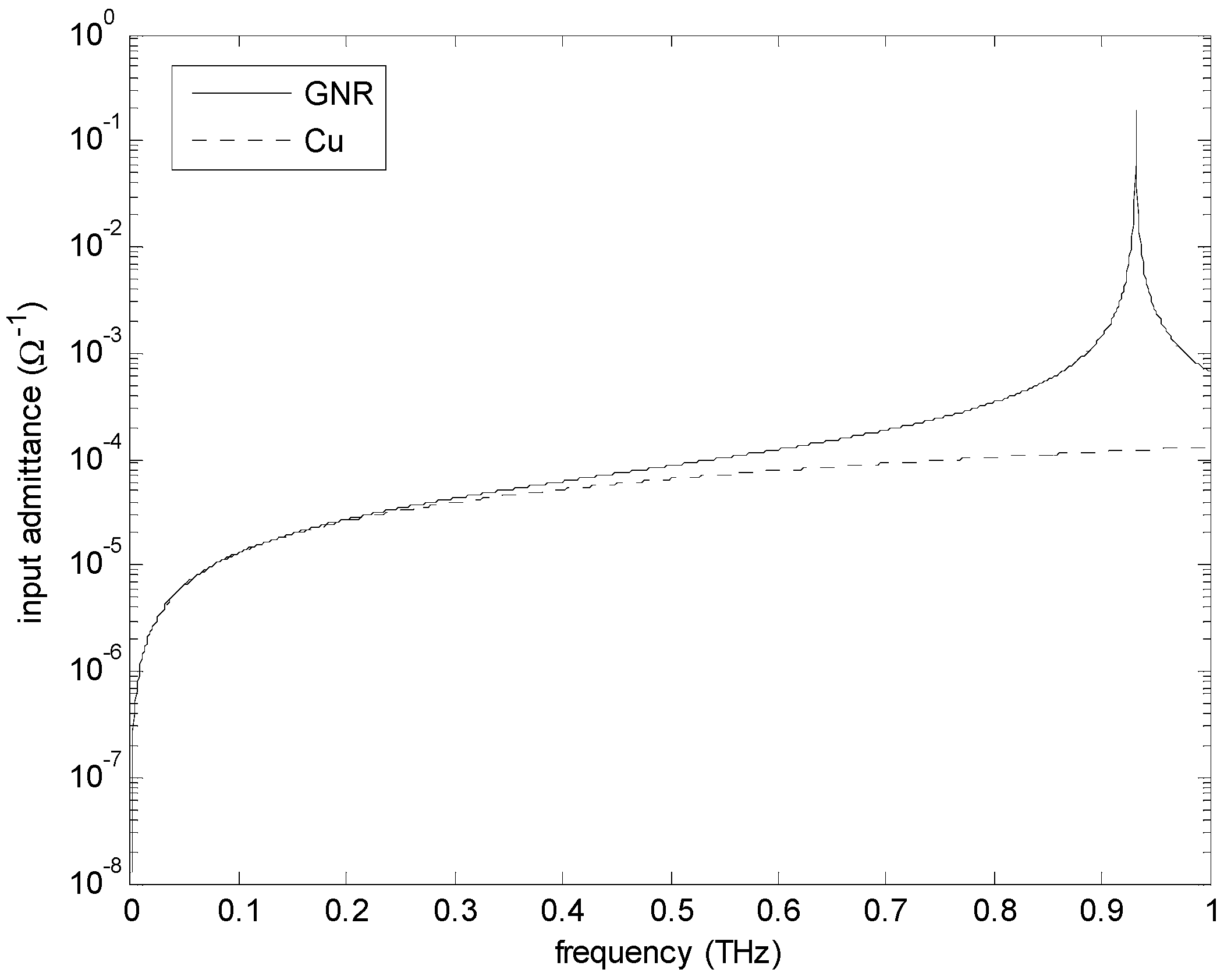
3.2. New THz Resonances for the Tunneling Effect

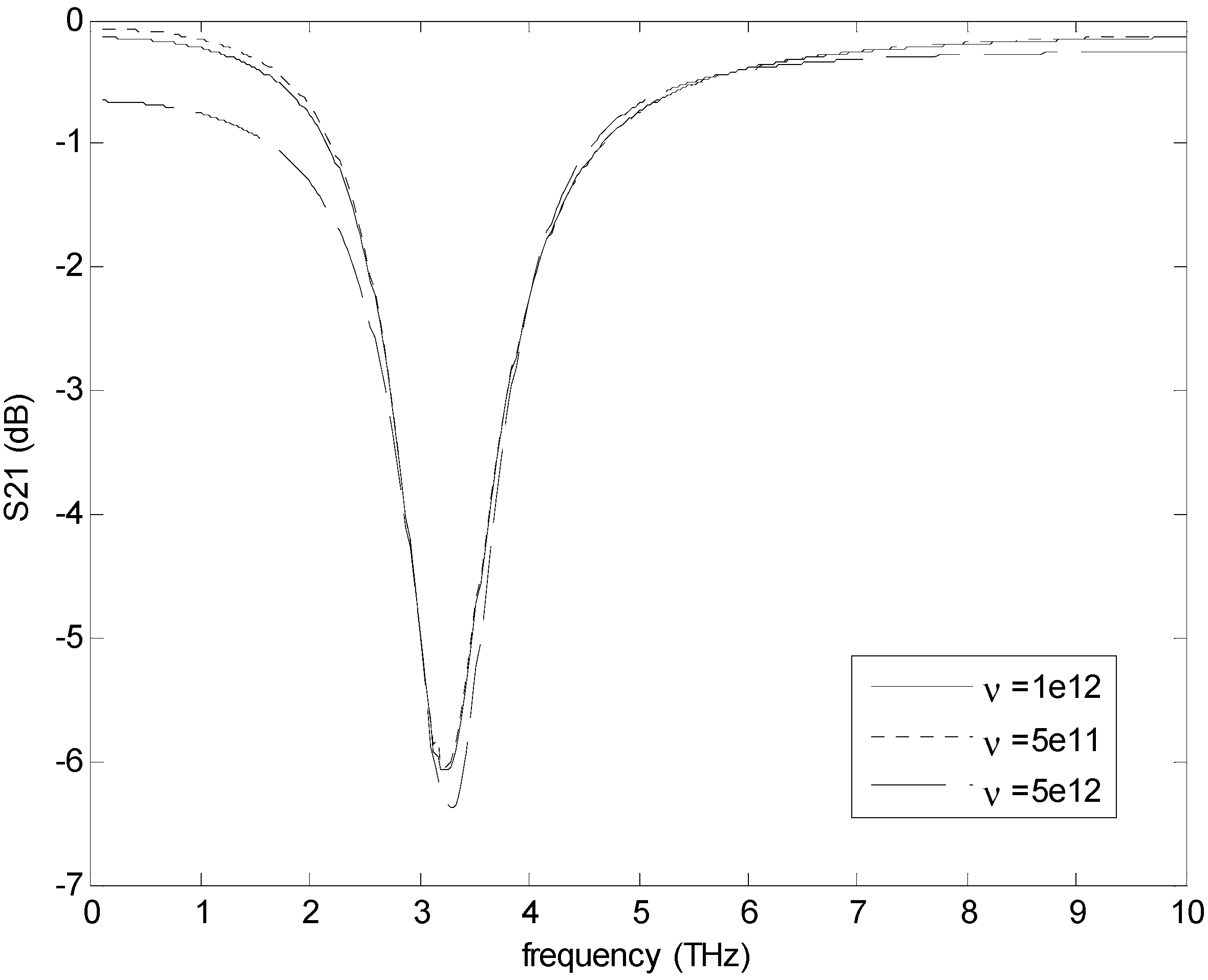
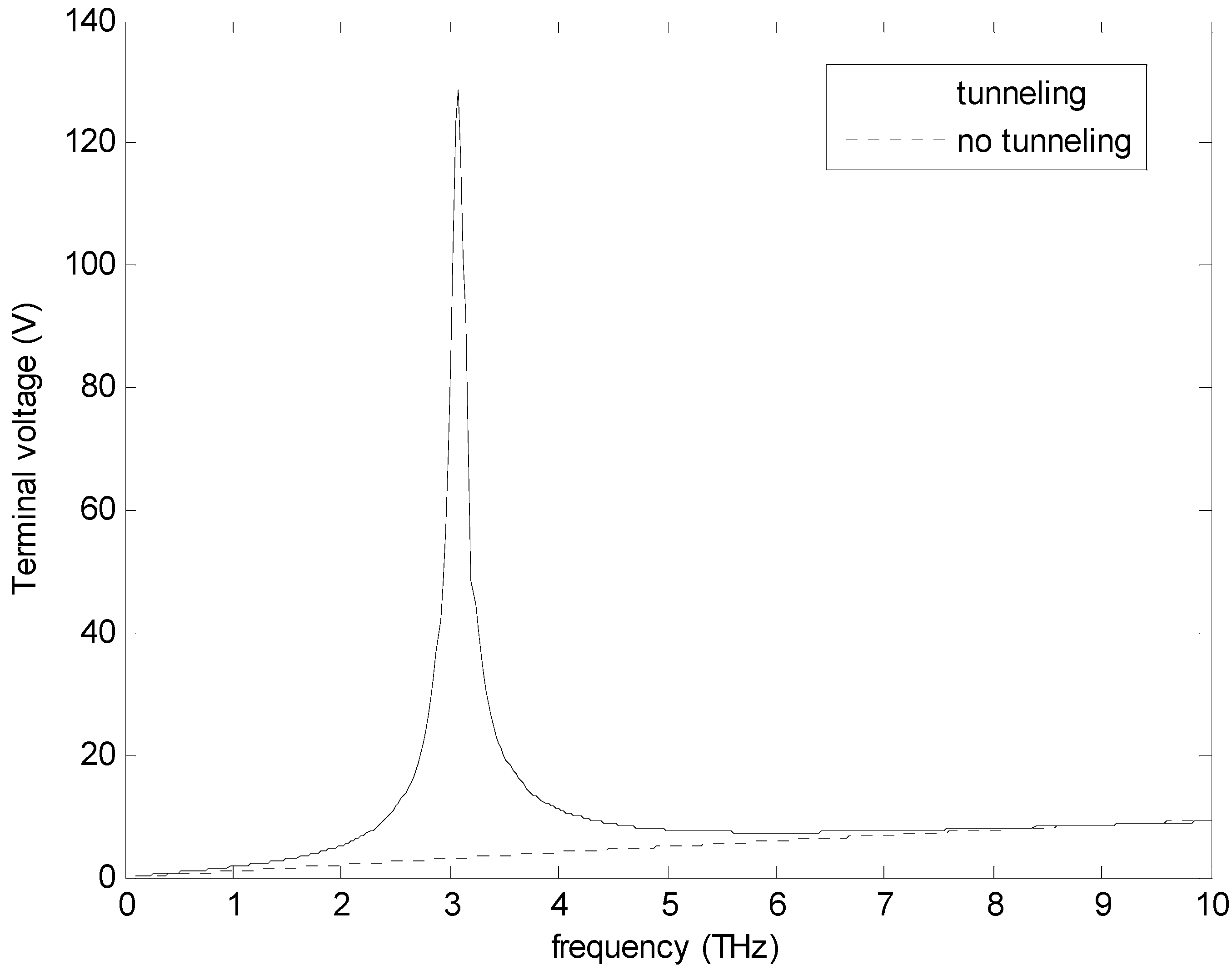
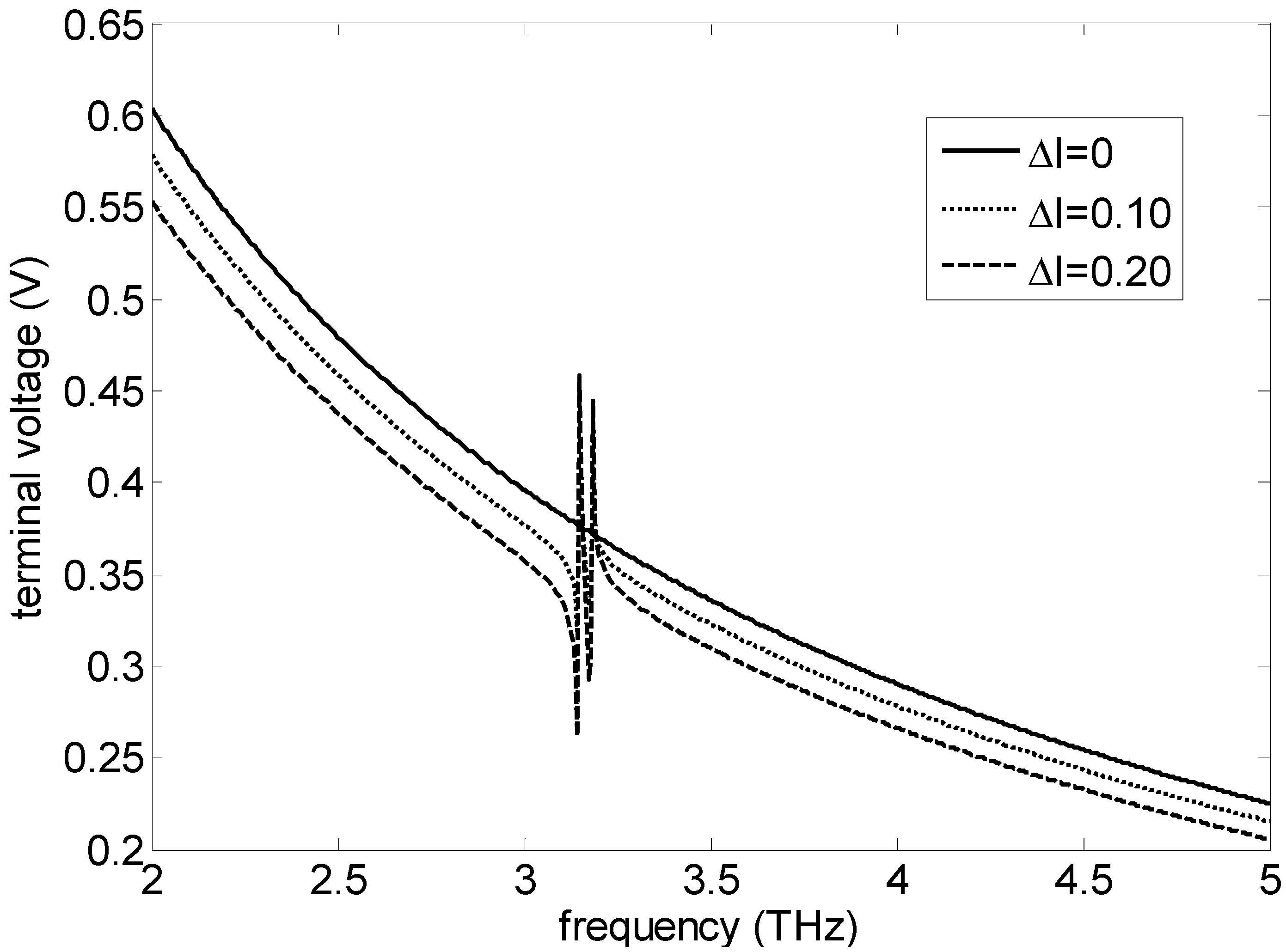
4. Conclusions
Acknowledgments
Conflicts of Interest
References
- Siegel, P.H. Terahertz technology. IEEE Trans. Microw. Theory Technol. 2002, 50, 910–928. [Google Scholar] [CrossRef]
- Ferguson, B.; Zhang, X.C. Materials for terahertz science and technology. Nat. Mater. 2002, 1, 26–33. [Google Scholar] [CrossRef] [PubMed]
- Kiyomi, S. Terahertz Optoelectronics; Springer: Berlin, Germany, 2005. [Google Scholar]
- Lee, G.M.; Wanke, M.C. Searching for a solid-state terahertz technology. Science 2007, 316, 64–65. [Google Scholar] [CrossRef] [PubMed]
- Hartmann, R.R.; Kono, J.; Portnoi, M.E. Terahertz science and technology of carbon nanomaterials. Nanotechnology 2014. [Google Scholar] [CrossRef]
- Li, H.; Xu, C.; Srivastava, N.; Banerjee, K. Carbon Nanomaterials for Next-Generation Interconnects and Passives: Physics, Status, and Prospects. IEEE Trans. Electron. Devices 2009, 56, 1799–1821. [Google Scholar] [CrossRef]
- Chen, X.; Akinwande, D.; Lee, K.-J.; Close, G.F.; Yasuda, S.; Paul, B.C.; Fujita, S.; Kong, J.; Wong, H.-S.P. Fully Integrated Graphene and Carbon Nanotube Interconnects for Gigahertz High-Speed CMOS Electronics. IEEE Trans. Electron. Devices 2010, 57, 3137–3143. [Google Scholar] [CrossRef]
- Van Noorden, R. Moving towards a graphene world. Nature 2006, 442, 228–229. [Google Scholar] [CrossRef] [PubMed]
- Avouris, P.; Chen, Z.; Perebeinos, V. Carbon-based electronics. Nat. Nanotechnol. 2007, 2, 605–615. [Google Scholar] [CrossRef] [PubMed]
- Renteria, J.D.; Nika, D.L.; Balandin, A.A. Graphene Thermal Properties: Applications in Thermal Management and Energy Storage. Appl. Sci. 2014, 4, 525–547. [Google Scholar] [CrossRef]
- Berres, J.A.; Hanson, G.W. Multiwall carbon nanotubes at RF-THz frequencies: Scattering, shielding, effective conductivity, and power dissipation. IEEE Trans. Antennas Propag. 2011, 59, 3098–3103. [Google Scholar] [CrossRef]
- Batrakov, K.; Kibis, O.V.; Kuzhir, P.; da Costa, M.R.; Portnoi, M.E. Terahertz processes in carbon nanotubes. J. Nanophotonics 2010. [Google Scholar] [CrossRef]
- Lin, I.-T.; Lai, Y.P.; Wu, K.-H.; Liu, J.M. Terahertz Optoelectronic Property of Graphene: Substrate-Induced Effects on Plasmonic Characteristics. Appl. Sci. 2014, 4, 28–41. [Google Scholar] [CrossRef]
- Brun, C.; Wei, T.C.; Franck, P.; Chong, Y.C.; Lu, C.; Leong, C.W.; Tan, D.; Kang, T.B.; Coquet, P.; Baillargeat, D. Carbon nanostructures dedicated to millimeter-wave to THz interconnects. IEEE Trans. Terahertz Sci. Technol. 2015, 5, 383–390. [Google Scholar] [CrossRef]
- Burke, P.J. AC performance of nanoelectronics: Towards a ballistic THz nanotube transistor. Solid-State Electron. 2004, 48, 1981–1986. [Google Scholar] [CrossRef]
- Shuba, M.V.; Slepyan, G.Y.; Maksimenko, S.A.; Thomsen, C.; Lakhtakia, A. Theory of multiwall carbon nanotubes as waveguides and antennas in the infrared and the visible regimes. Phys. Rev. B 2009. [Google Scholar] [CrossRef]
- Hanson, G.W. Fundamental transmitting properties of carbon nanotube antennas. IEEE Trans. Antennas Propag. 2005, 53, 3426–3435. [Google Scholar] [CrossRef]
- Rana, F. Graphene terahertz plasmon oscillators. IEEE Trans. Nanotechnol. 2008, 7, 91–99. [Google Scholar] [CrossRef]
- Kibis, O.V.; da Costa, M.R.; Portnoi, M.E. Generation of terahertz radiation by hot electrons in carbon nanotubes. Nano Lett. 2007, 7, 3414–3417. [Google Scholar] [CrossRef] [PubMed]
- Slepyan, G.Y.; Shuba, M.V.; Maksimenko, S.A.; Lakhtakia, A. Theory of optical scattering by achiral carbon nanotubes and their potential as optical nanoantennas. Phys. Rev. B 2006. [Google Scholar] [CrossRef]
- Burke, P.J.; Li, S.; Yu, Z. Quantitative theory of nanowire and nanotube antenna performance. IEEE Trans. Nanotechnol. 2006, 5, 314–334. [Google Scholar] [CrossRef]
- Llatser, I.; Kremers, C.; Chigrin, D.N.; Jornet, J.M.; Lemme, M.C.; Cabellos-Aparicio, A.; Alarcon, E. Radiation characteristics of tunable graphennas in the terahertz band. Radioengineering 2012, 21, 946–953. [Google Scholar]
- Zhang, Q.; Hároz, E.H.; Jin, Z.; Ren, L.; Wang, X.; Arvidson, R.S.; Lüttge, A.; Kono, J. Plasmonic nature of the terahertz conductivity peak in single-wall carbon nanotubes. Nano Lett. 2013, 13, 5991–5996. [Google Scholar] [CrossRef] [PubMed]
- Magda, G.Z.; Jin, X.; Hagymási, I.; Vancsó, P.; Osváth, Z.; Nemes-Incze, P.; Hwang, C.; Biró, L.P.; Tapasztó, L. Room-temperature magnetic order on zigzag edges of narrow graphene nanoribbons. Nature 2014, 514, 608–611. [Google Scholar] [CrossRef] [PubMed]
- Maffucci, A.; Miano, G. Transmission line model of graphene nanoribbon interconnects. Nanosci. Nanotechnol. Lett. 2013, 5, 1207–1216. [Google Scholar] [CrossRef]
- Maffucci, A.; Miano, G. Electrical Properties of Graphene for Interconnect Applications. Appl. Sci. 2014, 4, 305–317. [Google Scholar] [CrossRef]
- Maffucci, A.; Miano, G. Number of conducting channels for armchair and zig-zag graphene nanoribbon interconnects. IEEE Trans. Nanotechnol. 2013, 12, 817–823. [Google Scholar] [CrossRef]
- Chiariello, A.G.; Maffucci, A.; Miano, G.A. Circuit models of carbon-based interconnects for nanopackaging. IEEE Trans. Componen. Packag. Manufact. 2013, 3, 1926–1937. [Google Scholar] [CrossRef]
- Neto, A.H.C.; Guinea, F.; Peres, N.M.R.; Novoselov, K.S.; Geim, A.K. The electronic properties of grapheme. Rev. Modern Phys. 2009. [Google Scholar] [CrossRef]
- Wakabayashi, K.; Sasaki, K.; Nakanishi, T.; Enoki, T. Electronic states of graphene nanoribbons and analytical solutions. Sci. Technol. Adv. Mater. 2010. [Google Scholar] [CrossRef]
- Nakada, K.; Fujita, M.; Dresselhaus, G.; Dresselhaus, M.S. Edge state in graphene ribbons: Nanometer size effect and edge shape dependence. Phys. Rev. B 1996, 54, 17954–17961. [Google Scholar] [CrossRef]
- Miano, G.; Forestiere, C.; Maffucci, A.; Maksimenko, S.A.; Slepyan, G.Y. Signal propagation in single wall carbon nanotubes of arbitrary chirality. IEEE Trans. Nanotechnol. 2011, 10, 135–149. [Google Scholar] [CrossRef]
- Maffucci, A.; Miano, G. A general frame for modeling the electrical propagation along graphene nanoribbons, carbon nanotubes and metal nanowires. Comput. Modell. New Technol. 2015, 19, 8–14. [Google Scholar]
- Forestiere, C.; Maffucci, A.; Maksimenko, S.A.; Miano, G.; Slepyan, G.Y. Transmission line model for multiwall carbon nanotubes with intershell tunneling. IEEE Trans. Nanotechnol. 2012, 11, 554–564. [Google Scholar] [CrossRef]
- Cui, J.-P.; Zhao, W.-S.; Yin, W.-Y.; Hu, J. Signal Transmission Analysis of Multilayer Graphene Nano-Ribbon (MLGNR) Interconnects. IEEE Trans. Electromagn. Compat. 2012, 54, 126–132. [Google Scholar] [CrossRef]
- Slepyan, G.Y.; Shuba, M.V.; Maksimenko, S.A.; Thomsen, C.; Lakhtakia, A. Terahertz conductivity peak in composite materials containing carbon nanotubes: Theory and interpretation of experiment. Phys. Rev. B 2010. [Google Scholar] [CrossRef]
- Batrakov, K.G.; Saroka, V.A.; Maksimenko, S.A.; Thomsen, C. Plasmon polariton slowing down in graphene structures. J. Nanophotonics 2012. [Google Scholar] [CrossRef]
- Morimoto, T.; Joung, S.-K.; Saito, T.; Futaba, D.N.; Hata, K.; Okazaki, T. Length-dependent plasmon resonance in single-walled carbon nanotubes. ACS Nano 2014, 8, 9897–9904. [Google Scholar] [CrossRef] [PubMed]
- Ohta, T.; Bostwick, A.; Seyller, T.; Horn, K.; Rotenberg, E. Controlling the Electronic Structure of Bilayer Graphene. Science 2006, 313, 951–954. [Google Scholar] [CrossRef] [PubMed]
- Katsnelson, M.I.; Novoselov, K.S.; Geim, A.K. Chiral tunnelling and the Klein paradox in grapheme. Nat. Phys. 2006, 2, 620–625. [Google Scholar] [CrossRef]
© 2015 by the authors; licensee MDPI, Basel, Switzerland. This article is an open access article distributed under the terms and conditions of the Creative Commons Attribution license (http://creativecommons.org/licenses/by/4.0/).
Share and Cite
Maffucci, A. A New Mechanism for THz Detection Based on the Tunneling Effect in Bi-Layer Graphene Nanoribbons. Appl. Sci. 2015, 5, 1102-1116. https://doi.org/10.3390/app5041102
Maffucci A. A New Mechanism for THz Detection Based on the Tunneling Effect in Bi-Layer Graphene Nanoribbons. Applied Sciences. 2015; 5(4):1102-1116. https://doi.org/10.3390/app5041102
Chicago/Turabian StyleMaffucci, Antonio. 2015. "A New Mechanism for THz Detection Based on the Tunneling Effect in Bi-Layer Graphene Nanoribbons" Applied Sciences 5, no. 4: 1102-1116. https://doi.org/10.3390/app5041102
APA StyleMaffucci, A. (2015). A New Mechanism for THz Detection Based on the Tunneling Effect in Bi-Layer Graphene Nanoribbons. Applied Sciences, 5(4), 1102-1116. https://doi.org/10.3390/app5041102




